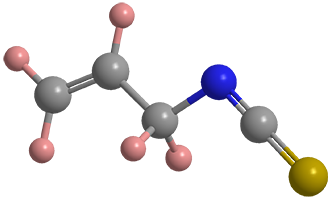What molecule am I?


Allyl isothiocyanate (AITC) is a natural compound found in cruciferous vegetables (family Brassicaceae) such as horseradish, mustard, radish, and wasabi. It first appeared in the chemical literature in three 1890s articles about isothiocyanates by Augustus E. Dixon at Queen’s College, Galway (Ireland, now the University of Galway). At the time, AITC was called “allylthiocarbimide”.
It was not until 1964 that AITC appeared in a biological study. Misao Kojima at Fukuoka University (Japan) identified it in dried wasabi (Japanese horseradish, Wasabia japonica) roots. The article even described the preparation of a wasabi sauce that contained 10 parts wasabi flour, 60 parts horseradish flour, 30 parts mustard flour, and 1.5 parts green pigment.
In a follow-up paper, Kojima and co-workers reported a gas chromatography study on wasabi powder in which they found that it contains substantial amounts of AITC and phenethyl isothiocyanate1 (PEITC), whereas horseradish (Armoracia rusticana) powder contains mainly PEITC.
In addition to natural sources, AITC is synthesized from allyl chloride2 and potassium thiocyanate3. The synthetic product is not used in foods; its primary uses are in crop protection products and bactericides.
Many of us enjoy wasabi, mustard, and other sauces; but it’s worth noting that AITC by itself is pretty nasty stuff, as shown in the hazard information table. It likely has more hazard statements than any other Molecule of the Week.
1. CAS Reg. No. 2257-09-2.
2. CAS Reg. No. 107-05-1.
3. CAS Reg. No. 333-20-0.
Allyl isothiocyanate hazard information*
| Hazard class** | GHS code and hazard statement | |
|---|---|---|
| Flammable liquids, category 3 | H226—Flammable liquid and vapor | |
| Acute toxicity, oral, category 3 | H301—Toxic if swallowed | |
| Acute toxicity, dermal, category 2 | H310—Fatal in contact with skin | |
| Skin corrosion/irritation, category 1B | H314—Causes severe skin burns and eye damage | |
| Skin sensitization, category 1 | H317—May cause an allergic skin reaction | |
| Serious eye damage/eye irritation, category 1 | H318—Causes serious eye damage | |
| Acute toxicity, inhalation, category 2 | H330—Fatal if inhaled | |
| Respiratory sensitization, category 1 | H334—May cause allergy or asthma symptoms or breathing difficulties if inhaled | |
| Specific target organ toxicity, single exposure, respiratory tract irritation, category 3 | H335—May cause respiratory irritation | |
| Specific target organ toxicity, repeated exposure, category 2 | H373—Causes damage to organs through prolonged or repeated exposure: liver, thyroid gland, digestive tract, kidney, bladder | |
| Short-term (acute) aquatic hazard, category 1 | H400—Very toxic to aquatic life | |
| Long-term (chronic) aquatic hazard, category 1 | H410—Very toxic to aquatic life with long-lasting effects | |
*Compilation of multiple safety data sheets. The greatest reported hazard is shown for each hazard class.
**Globally Harmonized System (GHS) of Classification and Labeling of Chemicals Explanation of pictograms.
Molecule in the News
Since the 1985 discovery of all-carbon buckminsterfullerene1 (C60), chemists have been intrigued with making a non-carbon “soccer ball” analogue. Some have been prepared that had to be stabilized by external ligands; but last November, a stand-alone all-metal fullerene was reported.
Zhong-Ming Sung at Nankai University (Tianjin, China) and colleagues at universities in China, Chile, and Germany synthesized [K@Au12Sb20]5− 2, a nearly spherical structure with the 32 gold and antimony atoms forming the “ball” and the lone potassium atom encapsulated in the center. The counterion is the potassium complex [K(2.2.2)cryptand]+ 3.
The researchers prepared [K@Au12Sb20]5− via a reaction between the Zintl phase K8SnSb44 and the gold complex Au(PPh3)Me5 in ethylenediamine solution. The presence of [2.2.2]cryptand6 promoted the reaction and supplied the chelating agent for the counterion. After a 5-day incubation period at 10 °C, black crystals were obtained that were confirmed by X-ray crystallography to contain the fullerene-like structure, a combination of an antimony dodecahedron and a gold icosahedron.
1. CAS Reg. No. 99685-96-8.
2. CAS Reg. No. 3030175-02-8, representing a generic molecule with the empirical formula Au12KSb20.
3. CAS Reg. No. 61624-59-7.
4. CAS Reg. No. 3030175-58-4.
5. CAS Reg. No. 23108-72-7.
6. CAS Reg. No. 23978-09-8.
Molecule in the News
MOTW highlights molecules that appear in major news outlets. See this week's edition below.
This molecule was suggested by a reader. We present almost all of the molecules suggested by our readers. If you have a molecule you would like us to consider, please send us a message. And thank you for your interest in Molecule of the Week! —Ed.
Allyl isothiocyanate
fast facts
| CAS Reg. No. | 57-06-7 |
| CA Index Name | 1-Propene, 3-isothiocyanato- |
| Empirical formula | C4H5NS |
| Molar mass | 99.16 g/mol |
| Appearance | Colorless to pale yellow oily liquid |
| Boiling point | 150–151 °C |
| Water solubility | 2 g/L (20 °C) |

Learn more about this molecule from CAS, the most authoritative and comprehensive source for chemical information.
Molecule of the Week needs your suggestions!
If your favorite molecule is not in our archive, please send us a message. The molecule can be notable for its current or historical importance or for any quirky reason. Thank you!
Stay Ahead of the Chemistry Curve
Learn how ACS can help you stay ahead in the world of chemistry.

